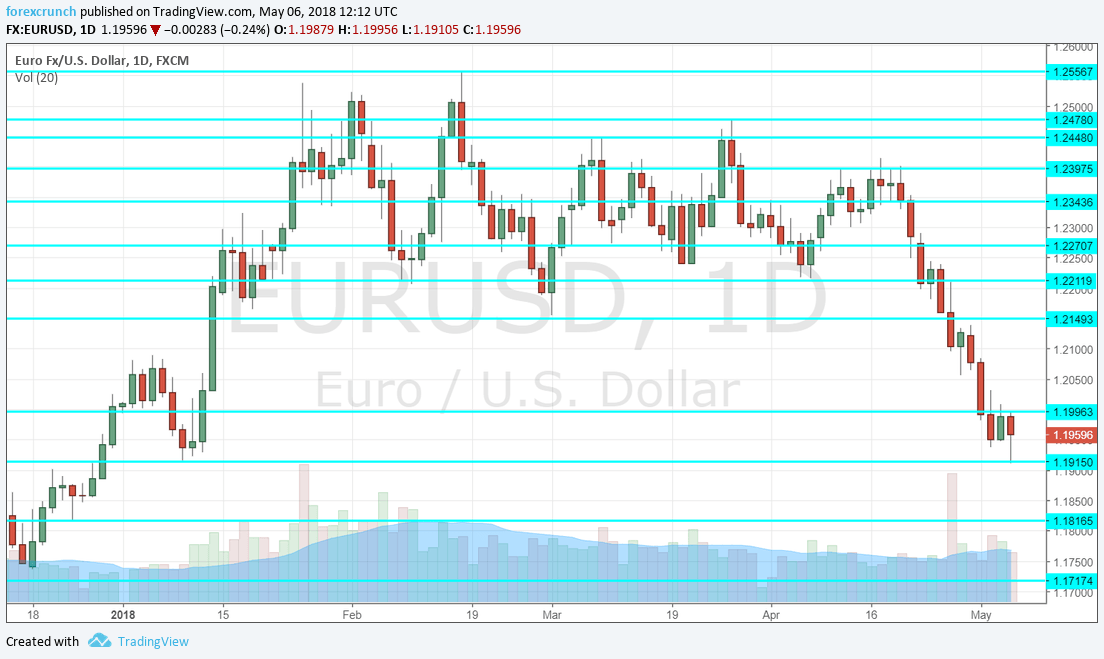EUR/USD extends its slump, falling to new 2018 lows in a perfect storm. Will we see further drops or did it have enough? A speech from ECB President Draghi stands out. Here is an outlook for the highlights of this week and an updated technical analysis for EUR/USD.
The adverse data continued pouring in the euro-zone.GDP growth slowed down to 0.4% q/q in Q1, as expected but inflation already provided new disappointments with a deceleration to 1.2% y/y on the headline a fall to 0.7% on the core. Purchasing managers’ indices and retail sales added to the misery. In the US, the Fed left the interest rate unchanged and sent a somewhat more cautious message, hinting that it could allow for higher inflation. The Non-Farm Payrolls reported disappointed on both job growth, 164K, and also on a slowdown in the wage growth: 2.6% against 2.7%. EUR/USD managed to recover on each US disappointment but recovered shortly thereafter showing the weakness of the pair.
[do action=”autoupdate” tag=”EURUSDUpdate”/]EUR/USD daily chart with support and resistance lines on it. Click to enlarge:
- German Factory Orders: Monday, 6:00. The euro-zone’s locomotive saw a modest increase in factory orders back in February: 0.3%. A slightly higher growth rate is forecast: 0.5% for March. It is important to note that this gauge is usually more volatile so a big surprise may be seen here. Dat from Germany has been mostly disappointing in recent weeks.
- Retail PMI: Monday, 8:10. Markit’s purchasing managers’ index for the retail sector stood at only 50.1 points, at an almost perfect balance between expansion and contraction. Actual retail sales did not shine either.
- Sentix Investor Confidence: Monday, 8:30. This 2800-strong survey fell from the highs above 30 points to 19.6 points in April, reflecting a downturn in optimism among investors and analysts. The figure for May is projected to see a small recovery: 21.2 points. Another slide would be worrying.
- German Industrial Production: Tuesday, 6:00. Contrary to factory orders, industrial output slipped in February by 1.6%. A rebound worth 0.8% is on the cards for March. Bad weather during this month may have had an adverse impact though.
- German Trade Balance: Tuesday, 6:00. Germany has a chronic trade surplus, but it fell short of expectations in February with a dip below 20 billion euros to 19.2. A similar figure is predicted now: 19.9 billion.
- French Industrial Production: Wednesday, 6:45. The second-largest economy in the euro-zone saw a big jump in industrial output in February: 1.2%. A more modest pace is on the cards for March: 0.5%.
- ECB Economic Bulletin: Thursday, 8:00. The European Central Bank publishes the information its members viewed at the most recent rate decision. The views on inflation and growth will likely be somewhat less optimistic than in the previous bulletin but the level of concern is unknown. A downbeat report could weigh on the euro.
- Mario Draghi speaks Friday, 13:15. The President of the European Central Bank will be speaking in Florence, Italy, his home country. In his last press conference in late April, Draghi recently described the Q1 slowdown as a moderation that is due to temporary factors. Since making that speech we learned that growth was indeed weaker and also inflation decelerated. Will he express more concern about the situation or does he still see it as temporary? Any reference to the economy and inflation will be watched closely and set to move markets.
* All times are GMT
EUR/USD Technical Analysis
Euro/dollar extended its falls, piercing through 1.20 and even temporarily dipping below 1.1915 (mentioned last week) but it eventually closed above this level.
Technical lines from top to bottom:
1.2412 was swing high in mid-April and also in March. 1.2345 remains a pivotal line. Further below, 1.2270 was a swing low in mid-February and mid-March. The 1.2210 level which served as a cushion in April is the next level to watch.
1.2155 was a low point in early March and the last line before 1.2090, the 2017 peak. 1.2060 was the low point in late April and it is the last barrier before the round number of 1.20. Even lower, 1.1915 was a stepping stone on the way up for the pair.
Further down, the 1.1820 level was a stubborn support line in late 2017 and 1.1710 is a veteran line that worked in both directions.
I remain bearish on EUR/USD
While the euro may be experiencing oversold conditions, there are good reasons to sell it. The slowdown is serious and extends beyond the first quarter. Draghi may be more dovish in his speech, weighing on the common currency. In the US, things are not perfect and the greenback may be overbought, but the economy is doing much better than in Europe and the Fed remains on course to raise rates.
Our latest podcast is titled Is inflation rearing its ugly head? Oil is on fire
Follow us on Sticher or iTunes
Further reading:
- GBP/USD forecast – Pound/dollar predictions
- USD/JPY forecast – analysis for dollar/yen
- AUD/USD forecast – the outlook for the Aussie dollar.
- USD/CAD forecast – Canadian dollar predictions
- Forex weekly forecast – Outlook for the major events of the week.
Safe trading!

